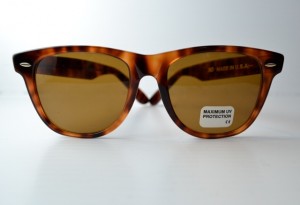It’s a story of the American dream turned to reality. William Beecher (1805-1892), born on a Connecticut farm, ventured to Providence for an apprenticeship in jewelry making. Little did he know how this decision would impact American history some years later. After moving to Southbridge Connecticut to practice his new trade, he tripped across a very crudely made – and unfortunately, very typical – pair of eyeglasses imported from Europe. “I can do it better,” he said to himself. And he did. The eyewear company he founded in 1833 eventually expanded and merged with other, smaller optical shops to become American Optical in 1869. By the turn of the century, it employed 2,000 workers and soon expanded to include an office in London.
Opthalmic eyeglasses were the original, but not the only, product of this early eyewear company. American Optical took its first step into the world of sunglasses in 1876 with tinted lenses in a variety of shades. The critical leap forward came in 1913 when the company obtained the rights to glasses invented by British scientist Sir William Crookes, which launched the concept of ultraviolet protection.
But fashion eyewear wasn’t enough for this innovative company. During the World War I, American Optical designed and built an amazing and truly innovative mobile eyeglass fitting facility to provide optical support to U.S. and Allied Forces in Europe. The mobile units – eight in all – contained frames, lenses, machinery and refraction equipment to allow qualified personnel in the field to conduct eye exams and fit troops with ophthalmic eyeglasses and sunglasses. Through these mobile facilities, American Optical provided 2.5 million eyeglasses to the U.S. Government during the war.
American Optical expanded its support to the war effort in the Second World War to include goggles, gun sights, bombsights and other optical instruments used for military hardware, as well as eyeglasses. In fact, American Optical’s contributions in support of the U.S. military were so substantial that the company received the Army-Navy “E” award in recognition of its efforts.

Underneath that helmet, Neil Armstrong’s wore American Optical pilot sunglasses when he made that historic first step onto the moon in 1960
The company’s connection to the U.S. military didn’t end with the war. In 1958, the company released the Flight Goggle 58, also known as the “Original Pilot Sunglass,” to give U.S. pilots maximum performance, protection and comfort. Apollo 11 Commander Neil Armstrong wore this sunglass when he stepped onto the surface of the moon in 1969 and it’s still in production today.
At least one Commander-in-Chief also benefitted from American Optical’s superior technology. A pair of American Optical sunglasses is among the collection of his personal effects on hand at the John F. Kennedy Memorial Library.
Through a stroke of great luck, we’ve acquired a collection of never-worn vintage American Optical sunglasses similar to the ones JFK wore – Wayfarer look-alikes with real glass lenses. We offer them for just $252. Come in and try them on for a walk down the lane of American history.



